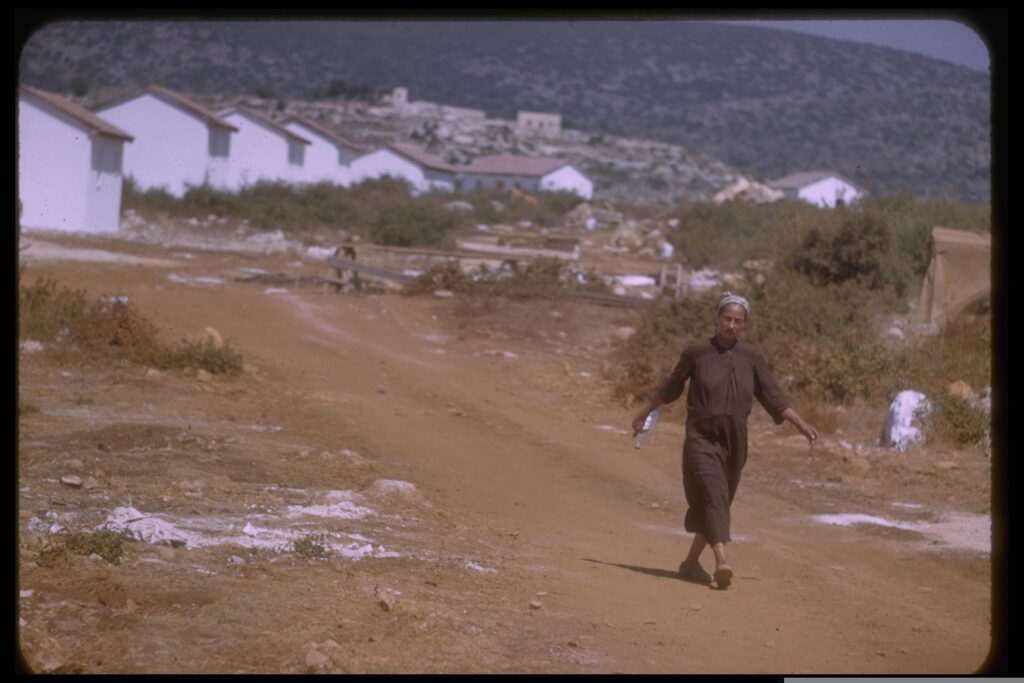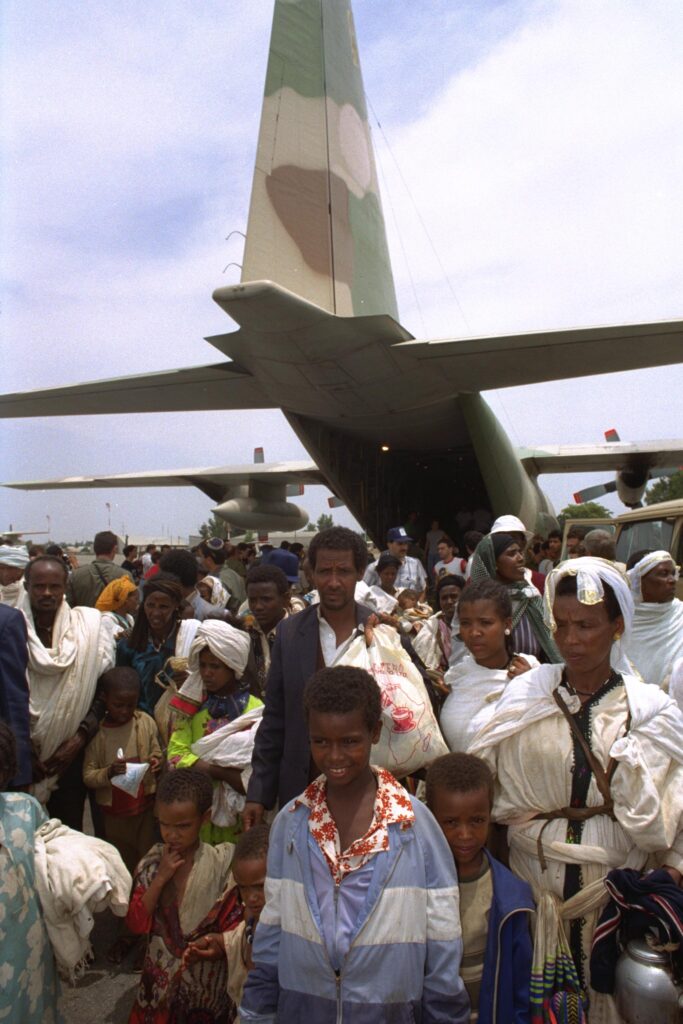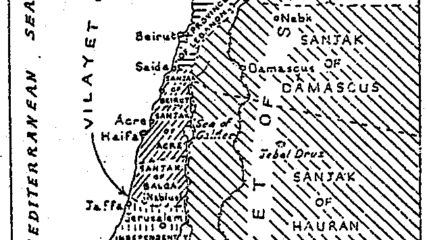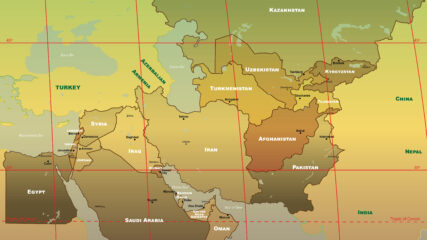By Scott Abramson and Ken Stein, April 4, 2025
The Exile and the Homeland
It may be said that the Jewish people’s entire cosmology (the origin and nature of the universe) from their birth as a people in the late Bronze Age (3300-1200 B.C.E.) down to the present day has centered on the Land of Israel. In the Jewish mind, there’s the Land of Israel, and there’s everywhere else. If a Jew was not in the homeland, he or she was in exile. It was only in the late 18th and early 19th century that some Jews in the Diaspora felt that they could unpack their bags and look upon life in other countries as a permanent condition rather than a passing phase. Even so, this remained a minority view in the Jewish world, limited to the assimilated Jewish communities of the more tolerant and prosperous West. Most Jews in the Diaspora, whether believers waiting for the Messiah or Zionists aspiring to self-government, understood themselves as exiles. Yet the Jewish connection to the Land of Israel was no recent phenomenon spawned by the evolution of modern nationalism; the centrality of Zion, of Jerusalem, is core to thousands of years of Jewish identity.
So central was the Land of Israel to the Jewish people’s spatial consciousness that it shaped their sense of direction. As prescribed by the Talmud (Berakhot 30a), Jewish worshippers turn toward Jerusalem when reciting their thrice-daily prayers and in many other places of Jewish liturgy. This orientation is emphasized in synagogue architecture, which places the ark (the niche enshrining the Torah scrolls) toward Jerusalem.
Even the everyday vocabulary of Jews places the Land of Israel at the center of their existence. In Hebrew, the points on the compass (i.e., north, south, east, west) take their names from landmarks in and around the Land of Israel, reflecting the geographical perspective of one in the Land of Israel. Thus, the Hebrew word for west is yam (“sea”) because the Mediterranean forms the country’s western border, and the word for south is negev because the desert of this name makes up the southern half of the country. In this way, proper nouns of fixed places in the Land of Israel became common nouns for general directions.
Space and language have overlapped in other ways to express the centrality of the Land of Israel in the Jewish consciousness. Just as Jewish existence is divided between the realms of the homeland and the galut (exile), the Hebrew language features different words for movement relative to the Land of Israel — depending on whether one is going to or leaving the homeland. The Hebrew word for immigrating to the Land of Israel is aliyah, a word so familiar to non-Jews that it’s recorded in English dictionaries. Meaning “ascent,” aliyah in antiquity was understood literally, as it described the physical rise in elevation of Jews ascending some 3,000 feet into the hill country of Judea. These Jewish ascenders might be pilgrims or returnees from Alexandria, Aleppo or Babylon.
In time, the meaning of aliyah turned from literal to metaphorical and from topographical to spiritual. A Jew bound for the Jewish heartland of Judea, the cradle of Jewish peoplehood and the seat of the Jewish capital, was rising to a higher plane of existence. The opposite of aliyah, the Jewish spiritual uplift, is yerida (“descent”), which degrades the Jewish expatriate to spiritual depths. Moses Maimonides, medieval Judaism’s greatest philosopher, even gave the stigma of yerida legal standing, ruling, “It is forbidden to emigrate from the Land of Israel and go abroad unless one goes to study the law or to marry a wife or to rescue property from heathens and then returns to the Land of Israel.” It was on this principle that the Rebbe, the last rabbi of the Chabad-Lubavitch dynasty, eschewed visiting the Land of Israel.
Like the directional words and the terms aliyah and yerida, the historical absence of certain Hebrew words attests to the dominance of the Land of Israel in the spatial awareness of the Jewish people. Although the Hebrew language, the oldest language in continuous use, is more than 3,000 years old, a word for “immigrate” wasn’t added to the Hebrew lexicon until the late 19th century, courtesy of Eliezer Ben-Yehuda, the moving spirit behind Hebrew’s revival. There was, however, a word meaning “to immigrate to the Land of Israel,” a verb derived from the same root as aliyah. How telling it is that despite the antiquity of Hebrew and the constant migrations of its speakers for millennia, the only word for “immigrate” was destination-specific, to immigrate to the Land of Israel. The Land of Israel, after all, was the only land worth immigrating to.
Aliyah in Jewish Law and Thought and the “Negation of the Diaspora”
The Romans’ genocidal massacres, deportations, and, finally, their vengeful ban on Jewish residence in Judea reduced the Jewish population of the Land of Israel such that more Jews lived in the Diaspora than in the homeland. But centuries earlier, ever since the first Jews were carried into exile, Jews were returning to the Land of Israel. The yearnings of the Diaspora’s first residents are immortalized in one of the best-known psalms, Psalm 137: “If I forget you, Jerusalem, may my right hand forget its skill.” With those words Theodor Herzl closed out the last Zionist Congress he attended.
The motives that impelled Jews to brave the hazards of premodern travel to the land of their ancestors varied. For some, living in the Land of Israel was important, but dying there was no less so because it meant being interred in sacred soil. The Talmud sanctifies this practice: “Whoever is buried in the Land of Israel is deemed to be buried under the altar.” Indeed, Jews throughout history trekked there in the twilight of their lives expressly to be buried on Jerusalem’s Mount of Olives, the world’s oldest Jewish cemetery.
The Talmud likewise sanctifies living in the Land of Israel, laying down that “it is better for a person to live in the Land of Israel in a city entirely of non-Jews than to live outside the land in a city entirely Jewish.” Nachmanides, the 13th century Spanish rabbi and philosopher, went further, ruling that living in the Land of Israel was no mere sacred act; it was a sacred obligation, “a positive commandment for all generations obligating every individual, even during the period of exile,” the pre-messianic age. To put precept into practice, Nachmanides braved long-distance travel to settle in Acre under the inhospitable rule of the Crusaders.
Yehuda Halevi, another eminent Jew from Muslim Spain, attempted the same journey, hoping to bridge the Diaspora-homeland divide lamented in the best-known line from his poetry: “My heart is in the East, and I in the distant West.” History does not record whether he united body and soul and reached the Land of Israel or if he died en route in Cairo.
If Nachmanides felt that it was incumbent on every Jew to live in the Land of Israel, Rabbi Nachman of Breslov, the great-grandson of the founder of Hasidic Judaism, felt that living in the Land of Israel was the only means to a complete Jewish existence. Rabbi Nachman spoke of the “ultimate level of faith which can only be achieved in the Land of Israel” and argued that “genuine enlightenment and wisdom come only in the Land of Israel.”
The doctrine that Jews are obliged to live in the Land of Israel and the belief that a complete Jewish life cannot be attained in exile are antecedents of Zionist principles, held by religious and secular Zionists alike. It didn’t matter, for instance, that Israel’s first prime minister, David Ben-Gurion, was an atheist when he echoed Rabbi Nachman’s pronouncement of three centuries earlier, declaring, “Only in the State of Israel is a full Jewish life possible.”
Ben-Gurion’s view is indeed a popular one in Israel. One of Israel’s most celebrated litterateurs, A.B. Yehoshua, described his estimation of Diaspora Jews starkly: “They are partial Jews, while I am a complete Jew.” Nor was Yehoshua the only literary luminary in Israel to speak of the Diaspora in Ben-Gurion’s idiom. Both Israel’s first prime minister and Natan Alterman called American Jews “Babylonians” because the largest Diaspora community, like some of the ancient Jewish exiles in Babylon, reserved the right to return home but chose not to exercise it.
These Israelis were enunciating a tenet of Zionist philosophy known as the “negation of the Diaspora” (shlilat hagolah), which holds that there is only one authentic and legitimate arena of Jewish life: the Land of Israel. It was in this spirit that Ben-Zion Dinur, the pre-eminent Zionist historian and Israel’s third minister of education, declared, “Zionism is a revolt against the Diaspora.”
Aliyah in Jewish Practice
Before the train and steamship revolutionized long-distance transport in the 19th century, travel was dangerous and often lethal. A strong constitution and good fortune were essentials; otherwise, adverse weather, wildlife, disease, dehydration, highway robbers and stranding threatened to intercept travelers. Typical was the experience of the 18th century preacher Judah the Hasid, who in 1700 led a caravan of some 1,500 Jews from Poland to the Land of Israel. By the time they reached their destination, disease had claimed a third of the party. Still, Jewish returnees to the Land of Israel have been numerous and constant. In the words of the Israeli Declaration of Independence: “Impelled by this historic and traditional attachment, Jews strove in every successive generation to re-establish themselves in their ancient homeland.”
Though the journey to the Land of Israel was the real hardship, life in premodern Palestine was no easy affair either. Palestine under Arab and Muslim rule became a thinly populated backwater with no city of importance to regional commerce except, to a limited extent, Ramle from the ninth through the 11th century and Acre from the mid-seventh to early 18th century. Far from immigrating for commercial or financial reasons, the Jews who returned to the Land of Israel were driven by religious, national and sentimental motives.
In recognition of the merit of living in the Land of Israel and in support of their kinsmen languishing in Palestine, Diaspora Jewry provided for the upkeep of these communities. A roving fundraiser known as an “emissary of Zion” (shaliach zion) would make his rounds, going from community to community to solicit alms from Jews in exile to sustain Jews in the homeland.
This Jewish return has been continuous since antiquity. These inflows of Jews to their homeland were sometimes a trickle, sometimes a wave and sometimes a flood. On occasion, these homecomings were coordinated, collective efforts, such as the Aliyah of 300 Rabbis, the immigration of French and British Jewish scholars in 1211, but mostly they were haphazard individual initiatives. The volume of immigration was often tied to an event in the Diaspora — a country’s expulsion of Jews, for instance — or anticipated an event in the homeland — namely, the coming of the Messiah.
In Jewish theology, it is believed that adversity and upheaval will usher in the messianic age, an event known as chevlei mashiach (“the [birth] pangs of the Messiah”). Because tribulation has been one of the salient features of Diaspora experience, Jews were inclined to think that the disasters that befell them time and again were preludes to the coming of the Messiah. In anticipation, Diaspora Jews would prepare for redemption by selling off their possessions and hastening home to the Land of Israel.
But it wasn’t only disaster that persuaded Jews to go to the Land of Israel in the belief that the messianic age was upon them; numbers convinced some. Using a system in which numbers correspond to Hebrew letters, Jews believed that certain years would bring the messianic age because certain configurations of numbers spelled words or acronyms related to the Messiah. Using this method of hishuv haketz (“calculation of the end” of exile), Jews were convinced that certain years — for example, 1648, 1700, 1706 and 1740 — portended the Messiah’s advent, so they made their way to Palestine to welcome him. The most recent such year was 1840 (5600 in the Hebrew calendar). Citing the Talmud and the Zohar, the central text of Kabbalah, such eminent rabbis as the Sephardic Judah Alkalai and the Ashkenazi Gaon of Vilna encouraged their disciples to return home to await the Messiah. One who heeded that call was Rabbi Moshe Rivlin, an ancestor of former Israeli President Reuven Rivlin.
Expulsion was another force that drove Jews back to their homeland. Expulsion was a theme of Jewish exilic experience, and many Jews banished from host countries simply sought refuge in the nearest place that would have them. But this often proved a temporary solution. In 1290, when England expelled its Jews, most of them settled in France, only to be expelled from there in 1306. The same was true Jews who were expelled from Spain in 1492 and went to neighboring Portugal, which in turn expelled them in 1497.
But many Jews were led by a search not only for shelter, but also for what 20th century Jewish philosopher George Steiner called “at-homeness.” And where else could a Jew feel at home than in the homeland?
Jewish expellees who preferred the familiarity of the homeland to the proximity of the closest open country have returned to the Land of Israel since the Second Temple Period (539 B.C.E. to 70 C.E.) despite the perils of long-distance travel.
Such was the decision of the two Jewish tribes expelled from the city of Medina by Mohammed and from the Hijaz by his successor, Omar. Many Jews expelled from Muslim Spain in the 12th century and from Christian Spain in the 15th century made the same choice. These Jewish expellees could have stayed closer to Iberia, but they chose to return home and thus formed the largest mass repatriation of Jews until the Zionist aliyot of the late 19th century.
These Sephardic refugees didn’t merely settle in the Land of Israel; they transformed it. They turned Safed into a center of learning and Kabbalah, setting up there the first printing press in western Asia. In 16th century Hebron, under the leadership of Rabbi Malkiel Ashkenazi, “the father of Hebron settlement,” they resuscitated the town’s languishing Jewish community.
In Tiberias, Sephardim didn’t just revive the Jewish community; they rebuilt the town itself. Only a few years earlier, an Italian rabbi had described Tiberias as “in ruins and desolate,” where “no man can walk for fear of the Arabs.” But after Sephardi philanthropists secured the Ottoman sultan’s personal permission by way of a decree, the refugees breathed new life into a landscape that had been a wasteland. Olim (those who make aliyah) can also be credited with the renewal of Jewish life in Tiberias after the town was twice destroyed in the ensuing centuries. The Jewish community of Tiberias was revived by Rabbi Chaim Abulafia from Turkey after the Druze laid waste to it in 1660 and by Rabbi Haim Shmuel Hacohen Konorti from Italy after an earthquake reduced it to ruins in 1837.
Olim made their indelible mark on other cities of the Land of Israel well before the emergence of Zionism. Thanks to immigration mostly from Eastern Europe, the Middle East and North Africa, the Jews of Jerusalem attained a residential majority in the 1860s. One Jewish community founded by immigrants proved especially helpful to the Zionists who began arriving in the 1880s. The descendants of the mostly North African olim who established the Jewish community in Jaffa around 1800 helped the Zionist arrivals at the end of the century, smoothing obstacles for them in an unfamiliar environment. Providing hospitality, facilitating land purchase and interceding with the Ottoman bureaucracy on their behalf, the veteran Jewish residents of Jaffa rendered many valuable services to the Zionists, only the latest Jews to continue the 2,500-year-old tradition that the Jews of Jaffa (or their recent ancestors) had themselves upheld: returning home.
Pre-State Immigration (1882-1948)
Reconnecting Diaspora Jews to the Land of Israel was essential to Zionism’s success. How and why Jews embraced Zion anew and where they settled are explained in depth in “Forming a Nucleus for the Jewish State” (Spanish, Hebrew, German). The First Aliyah (1882-1903) began five waves of Jewish immigration to Eretz Israel before the establishment of the State of Israel in 1948. This aliyah comprised individuals and small groups like Hibbat Zion and BILU, the two most influential groups that settled in the Land of Israel during this period. Leaving behind Russian pogroms — state-supported massacres of Jews — and driven by idealism, they aspired to create a Jewish home for themselves in the Land of Israel. By 1903, 25,000 immigrants had established 28 agricultural settlements and Mikveh Israel, the first Jewish agricultural school in Palestine. Hebrew was modernized and expanded as a spoken language, and 90,000 acres were purchased.
Fear and insecurity from the 1903 Kishinev pogrom and other systematic government attacks in Russia drove some the 40,000 Jews to immigrate to Palestine during what came to be called the Second Aliyah (1904-1914). Jews purchased more than 50,000 acres (200,000 dunams) from Arab owners, with other large areas in the Jezreel Valley south of Haifa in initial stages of negotiations that were consummated in the 1920s. The newcomers possessed an idealistic fervor similar to that of the First Aliyah and brought the beliefs of socialism, setting the stage for Labor Zionism, one of the foundations of the Jewish state. The Second Aliyah arrivals coincided with the early years of the official Zionist enterprise, including the opening of a Palestine office of the Zionist Organization in Jaffa in 1908. In 1909 and 1910, the first kibbutz (Degania), the first modern Jewish city, Tel Aviv, and the first self-defense group, Hashomer, were established. Hashomer was a precursor of the Haganah, established in 1920 and itself the forerunner of the Israel Defense Forces. For decades before the British articulated the Balfour Declaration to “facilitate the development of a Jewish National Home in Palestine,” Jewish immigrants were linking people to the land.
The Third Aliyah (1919-1923) coincided with the aftermath of the Russian Revolution and World War I. Fear, insecurity and the hope of nation-building motivated many of these immigrants. The 1917 Balfour Declaration and British control over Palestine offered the prospect of stability and security. The new British administration in Palestine sought to elicit Jewish and Arab participation in local government. The Zionists participated, but the Arab political community boycotted. Eretz Israel drew 35,000 immigrants. Most came from Russia, Poland, Lithuania and Romania; a few hundred came from Western Europe.
Those in the Third Aliyah were mostly young people, many single males, who had received preparatory agricultural training. Upon arrival, they were ready to do pioneering and organizational work. They established the Histadrut labor federation, small businesses, political parties, the Haganah and, in 1921, the Palestine office of the Jewish National Fund.
During the Fourth Aliyah (1924-1929), the British continued their policy of dual obligation to the Jewish and Arab communities. In the areas of Jewish land settlement and immigration, British policy was neither to make Palestine wholly Jewish nor to subordinate Jews to the Arab population. In immigration, Britain applied an ambiguous formula established in a 1922 policy statement of the “economic absorptive capacity of the country” to take in immigrants. Zionists argued that such a capacity was limitless, while the Arab leadership insisted that immigration and land purchase be halted and that the entire idea of a Jewish national home come to an end. Unlike the previous waves of immigration, this aliyah was driven by economic forces and the U.S. Immigration Act of 1924, whose national-origin-based quotas largely halted Jewish immigration to the United States. While improved economic conditions in Palestine made it more attractive to immigrants, 1927 saw a brief period of increased Jewish emigration from Palestine.
But more than 80,000 Jews immigrated to Palestine in the Fourth Aliyah. Middle-class newcomers settled in towns and invested in workshops, small factories, restaurants and shops. They contributed to the development of the coastal region by developing agricultural villages with citrus orchards. Thousands invested their own savings in new enterprises, indicating deep personal commitments to Zionist aspirations. Early in this period, the British administration acknowledged that the Jewish community was creating political, social and economic separation from the Arab community.
The Fifth Aliyah (1929-1936) was spurred by an increased commitment to Zionism among European Jews and the rise in antisemitism and Nazism in Germany and was compounded by difficulties in immigrating to the United States and Canada. Some 250,000 Jews immigrated, and Zionists purchased 80,000 acres. These seven years saw the largest Jewish demographic and geophysical increases of the British Mandate period.
From early 1932 onward, the Palestinian Arab press repeatedly castigated Palestinian leaders, small owners and land brokers for engaging in land sales to Jews. More than a quarter of the immigrants came from Germany and Austria. They brought a good deal of capital, contributing to economic growth in the Jewish sector and expanding trade, industry and agriculture. Most of these immigrants settled in urban areas and contributed to business, medicine, education, literature and music. One-fifth of this aliyah settled in kibbutzim and moshavim. Careful assessments were made about which lands should be purchased for building rural settlements, where populations could sustain themselves with incomes generated in and commercial profits made on the world market. Offers to Jewish buyers outstripped their capacity to acquire land.
Britain’s White Paper of 1939 limited Jewish immigration to 75,000 over five years, after which Jewish immigration would be prohibited unless an unlikely accommodation with the Arabs could be reached, and gave Mandate authorities the power to restrict or prohibit land sales to Jews. Jewish immigration to Palestine slowed enormously, though illegal immigration continued. Jewish land buying was stunted but did not halt; in fact, Arab sellers and Jewish buyers continued land transfers at a significant and sophisticated pace. The Land Transfer Inquiry Committee report of 1945 details the frequency of such transfers and the methods of circumventing the transfer prohibitions. Zionist decision-makers established settlements on already-purchased but not-yet-occupied lands that filled in heavily Jewish areas on the coastal plain, in valley regions and along the Tel Aviv-Jerusalem road.
From 1945 to 1948, Zionists established 42 settlements in Palestine, with a notable concentration around Beersheba. Since the early 1940s, Ben-Gurion had emphasized in JNF meetings the necessity for Zionism and the future Jewish state to have a presence in the Negev, situated as it was between Egypt in Sinai and Jordan on the eastern borders of Palestine. Moreover, he advocated acquiring land near the southern port of Eilat as a future water outlet. Jews did not make large numbers of land acquisitions in those areas, but Ben-Gurion’s intentions were clear. Because of vigorous British enforcement of immigration restrictions, Jews who left Europe after World War II were mostly barred from Palestine, but some 150,000 Jews immigrated illegally. After Britain handed the issue of Palestine to the United Nations, the Mandate authorities continued their policy of limiting the growth of the Jewish national home.
Immigration to Israel
“The State of Israel will be open for Jewish immigration and for the Ingathering of the Exiles,” reads the Israeli Declaration of Independence. When this proclamation was issued May 14, 1948, some 6% of the world’s Jewish population (650,000) lived in the Jewish state. Today, just under half of the world’s Jews (7.7 million) call Israel home. Demographers project that within the next two decades Israel will host the world’s Jewish majority. When that comes to pass and more Jews live inside Israel than outside of it, the population balance between the Jewish homeland and the Jewish Diaspora will be restored for the first time since antiquity.
Although the “ingathering of the exiles” was always a central tenet of Zionism, the British,
though ostensibly committed to advancing Zionism, had restricted Jewish immigration since their first year in Palestine, 1918. It was thanks to Britain’s closure of the gates of Palestine that history remembers the 1940s as the decade that brought the two defining events of modern Jewish experience, the Holocaust and the founding of the State of Israel. Had the order been reversed and Israel founded first, only one of these events would have occurred.

The priority given to immigration in the Jewish state was reflected not merely in the Declaration of Independence’s reference to it, but also in the first ordinance adopted by the Israeli government. No sooner had Ben-Gurion finished reading the Declaration of Independence aloud than he read another text, an edict annulling the 1939 White Paper, the document that restricted the admission of Jewish refugees to 75,000 over five years. Other government measures related to immigration soon followed. In 1948, Israel set up an entire governmental department for immigration, the Ministry of Aliyah (redesignated by its current name, the Ministry of Aliyah and Integration, in 1951).
In 1950, the Knesset, Israel’s parliament, unanimously enacted what is probably Israel’s best-known and arguably most consequential law, the Law of Return. This legislation stipulates that all Jews the world over have the right to immigrate to Israel and to receive full Israeli citizenship. The law has been amended twice: first, in 1954, to exclude Jews with a criminal history and second, in 1970, to bring closure to the question of who is a Jew. The 1970 amendment answers this tangled question by adopting the same criteria by which the Nazis’ 1935 Nuremberg Decrees defined a Jew. Under this definition, a Jew is a person who descends from a Jewish grandparent or is married to one who does.
While countries like Greece and Ireland have laws for naturalizing members of their diaspora, Israel stands alone among the countries of the world in involving its intelligence community in immigration. Since the Mossad’s founding, one of its main responsibilities has been to assist Jews in hostile countries to immigrate to Israel. In parallel with the Mossad, the Israeli prime minister’s office in 1951 set up Nativ, an intelligence organization devoted to fostering ties with and encouraging the immigration of the Jews of communist countries.
Immigrants’ Countries of Origin and the Mizrahim
Israel is the quintessential country of immigrants. Today almost a quarter of Israelis are foreign-born, but the rest of the population consists overwhelmingly of the children and grandchildren of immigrants. The journey of Israelis’ recent ancestors began in about a hundred countries across all six inhabited continents. But two parts of the Jewish world contributed the majority of Israeli immigrants over the years. The first is Eastern Europe — specifically, the contiguous expanse of territory that included the Russian Empire, Hungary and Romania. The second is the Islamic world. Jews came to Israel from some 15 Arab countries and, in lesser numbers, from Iran, Turkey, Kurdistan and Bukhara (historical region in modern Uzbekistan). Still fewer came from Afghanistan and Pakistan. While the mass of Israelis emigrated from Eastern Europe and the Islamic world, the rest came from Australia, India, sub-Saharan Africa (Ethiopia and South Africa almost exclusively), the Americas (mainly the United States, Canada and Argentina), and Western Europe (mainly France and Britain).
No less varied than their countries of origin are the communal profiles of these immigrant groups, diversified as they are by education, occupation, religiosity and mores. Common denominators among them were few; just about all that could be said of their common attributes was that they, like most Jews throughout the world since the 11th century, were overwhelmingly urban (i.e., not peasants engaged in agriculture). But what bound all of them together was the very thing that brought them all to the state in the first place: their common heritage.
In the first three years of Israeli statehood, the influx of Jewish immigrants doubled the country’s population. In Israeli collective memory, this three-year mass migration is known as the Great Aliyah.
The numbers fell after 1952, only to spike again in the latter half of the decade. While Holocaust survivors in European displaced persons camps and Russian, Romanian and Polish Jews figured prominently among these immigrants, the majority were from the Arab and Islamic world. And while the violence against Jews in Europe abated after the Holocaust, with a few notable exceptions, the ordeal was just beginning for Jews of the Arab and Islamic world.
Starting in Libya in November 1945, Jewish communities throughout the Arab world were attacked, terrorized and harassed. As the United Nations began deliberating on a solution to the Zionist-Arab conflict in 1947, Arab governments used threats against their Jews as leverage to prevent the establishment of a Jewish state. The Iraqi prime minister warned, “Should it come to a clash of arms, severe measures should be taken against all Jews in Arab countries.” Egypt’s U.N. representative warned that “the lives of 1 million Jews in Muslims countries would be jeopardized by the establishment of a Jewish state.”
They made good on their threats. The Jews of Arab lands became the easy prey of mobs avenging developments, political and military, in Palestine. Pogroms broke out in Aden (December 1947), Manama (December 1947), Aleppo (December 1947), Tripoli (June 1948), Oujda (June 1948), Djerada (June 1948) and Cairo (June 1948). Thus began the ethnic cleansing of the 850,000 Jews in the Arab world, a number that now hovers around 5,000.
The massacres, incitement and harassment led to a stampede of Jews trying to flee the country. For their part, the Mizrahim did not see themselves merely as refugees fleeing to a sanctuary; they also saw themselves as returnees going back to their homeland. Disembarking in Israel, many knelt to kiss the sacred soil. But the joy of being restored to the country of their ancestors was soon embittered by the trials of being in a country that was ill equipped to receive them. The late 1940s and 1950s were Israel’s lean years. It was a time of austerity, and the government, which enforced rationing, did not command the resources to give the newcomers a more hospitable welcome.
Most of the Jewish refugees were lodged in dormitory-like immigrant camps (machane olim) before being transferred to transit camps (ma’abarot) with single-family units, though with shared washrooms. Some of these ma’abarot eventually grew into towns and even cities, Kiryat Shmona, Sderot and Yavne among them.
The conditions in the ramshackle ma’abarot were shockingly rudimentary. For many of the new immigrants, life in the transit camps — squalid, aswarm with people, unsanitary — was a rude awakening from the dream of being in the homeland. Of all these groups, none was hit harder than the Jews of Iraq and Egypt. These communities consisted not only of a large bourgeoisie, but also were moneyed and cosmopolitan. Their descent was an especially steep one, from palatial villas in Baghdad and Alexandria to hovels in the Negev.
Besides being housed in immigrant camps and ma’abarot, the Mizrahim were sent to “development towns,” established on the country’s periphery (principally the Galilee and the Negev) in the interest of national defense and development. They were intended to settle Israel’s thinly populated, vulnerable borderlands and to distribute the Israeli population more evenly. Most of the Jewish state’s population was clustered on the coastal plain, while the hinterlands remained wildernesses. Eventually, two dozen development towns were built under the 1951 Sharon Plan, conceived by architect Arieh Sharon, the head of the planning authority in the Office of the Prime Minister. Some localities, whether neighborhoods or suburbs of big cities, became associated with one Mizrahi group in particular. Rosh HaAyn became synonymous with Yemeni Jews, while Ramat Gan became known as Little Baghdad.
Culture shock compounded the challenges of life in the ma’abarot. Israel was led by Mapai, the predecessor of the Labor Party, which promoted secularism, championed socialism and celebrated agriculture — three things that held little charm for overwhelmingly observant Mizrahim who valued private property and viewed agriculture as the drudgery of peasants.
To make matters worse, the largely Eastern European Israeli establishment was indelicate in its treatment of the Mizrahi newcomers and dismissive of their culture, regarding it as primitive or unworthy. This attitude of cultural condescension rankled the newcomers, alienating them from the establishment. The passage of time, the success of Mizrahim and greater popular respect for multiculturalism have dimmed this attitude, but it has not vanished. Consider, for instance, a remark in 2010 by Natan Zach, Israel’s most influential poet in the latter half of the ’50s: “The one lot [Ashkenazim] comes from the highest culture there is, Western European culture, and the other lot [Mizrahim] comes from the caves.”
The Mizrahi immigrants to Israel, in contrast to their Ashkenazi counterparts, labored under many disadvantages. Whereas Ashkenazi immigrants tended to have relatives and contacts in the country, Mizrahim often didn’t. This meant that the Ashkenazi newcomers had a support system and social network waiting for them. Because the Ashkenazim’s contacts most likely lived in the center of the country, where most Israelis lived, they benefited from proximity to the nucleus of commerce and industry. The Mizrahim, in contrast, often wound up in the undeveloped periphery. The Ashkenazim also boasted considerably higher levels of education, a consequence of coming from Europe, where the standard of living was much higher than in the Middle East. Differing religious and social values likewise played a part in the widening disparity between Ashkenazi and Mizrahi immigrants. For instance, Ashkenazi women were much more likely to be employed than Mizrahi women, who were often homemakers. This higher rate of voluntary female unemployment naturally led to lower household incomes. Similarly, Mizrahi families were larger than Ashkenazi families, which hampered capital accumulation and inherited wealth.
Reparations to Holocaust survivors, paid individually under agreement between the Conference on Jewish Material Claims Against Germany and the West German government, afforded another advantage to the Ashkenazim. In consequence of all these disparities in education, location, family size and employment, the upward mobility of the Mizrahi immigrants was hindered, and an overwhelmingly Mizrahi underclass was created.
Although the Mizrahim would become a numerical majority in the 1960s, this predominance was not reflected at the political level. What’s more, they were often underprivileged in the government’s resource allocation. This deprivation, together with the cultural condescension of many in the government, alienated many Mizrahi Jews from the ruling Labor Party.
The event that led to increased Mizrahi representation and political engagement was the Likud party’s 1977 electoral victory. After three decades of Labor hegemony, Likud came to power, thanks in no small part to the widespread support of Mizrahi Jews. Even before the establishment of the state, Mizrahim were drawn to the right. Vladimir Jabotinsky, the godfather of the Israeli right, and his protege Menachem Begin had admired Mizrahim, never treating them with the arrogance that characterized the Labor Party’s dealings with them.
Not only did the Mizrahim vote for Likud, but Haredi Mizrahim founded their own religious party, Shas, in 1984. Whereas political parties in Israel are often short-lived affairs, going defunct within years of being founded, Shas has proved resilient. In the 1999 election, it registered its best showing ever, garnering 17 seats and thus becoming the third-largest party in the Knesset.
Since the 1980s, Mizrahim have risen to the highest echelons of the Israeli military and political system, serving repeatedly as president, chief of staff, defense minister and foreign minister, but not yet prime minister. Just as Mizrahi representation in the corridors of power has increased, so has Mizrahi income. So upwardly mobile have the Mizrahi become that the gap between the income of Mizrahim and Ashkenazim is now negligible.
The cultural influence of Mizrahim has expanded correspondingly. The Mizrahi contribution to Israeli literature, cinema, television, poetry, and especially music and cuisine is pronounced. Two Israeli media scholars have shown that, in contrast to the past, when Mizrahim were stigmatized with unflattering stereotypes, in today’s Israel the Mizrahim are associated with positive attributes like warmth, family closeness, hospitality and festivity. “The New Israeliness is Mizrahi,” they proclaim.
Jews From the Soviet Union and Eastern Bloc
After the Six-Day War, around the time that Mizrahi immigration began dropping off, immigration from the Eastern Bloc (Poland) and the Soviet Union started to surge. The Soviet Union had made little distinction between Israel and its own Jews, whom it had mistreated for decades. After Israel’s victories in 1956 and 1967, the Soviets retaliated against their own Jewish citizens, tightening restrictions on emigration. The Soviet restrictions had become so onerous that by the early 1970s the American government adopted measures on behalf of the “refuseniks” (Soviet Jews barred from emigrating). The end of the Warsaw Pact in 1989 and the Soviet Union in 1991 brought the end of these restrictions. With the floodgates suddenly flung open, more immigrants poured into Israel than the country had received at any time since its first three years. By the time the immigrant inflows slowed from a gush to a trickle at the end of the 1990s, nearly a million former Soviet citizens had made their home in Israel.
The absorption of these newcomers presented certain difficulties for Israel, particularly where employment was concerned. In the first place, absorbing the immigrants was costly, a burden Israel sought to relieve by securing loan guarantees from the United States. Moreover, many of the former Soviets were highly educated, highly skilled professionals, but the supply of such excellent human capital far surpassed the demand in the Israeli job market. Underemployment — work that does not make full use of a worker’s talents — became a chronic problem.
For all these challenges, the ex-Soviet Jews made valuable contributions to Israel’s economy, particularly in the high-tech sector, its society, and its cultural scene, particularly in music. Israel’s political, residential and artistic landscape was likewise changed by the Soviet influx, as Russian newspapers, restaurants, musical events, political parties, neighborhoods and towns sprung up throughout the country. In time, the Israeli melting pot would absorb these Russian additives, assimilating them and giving new piquancy to the dominant Israeli flavor.
Ethiopian Jews
Until the late 1970s, if Israelis encountered one of the few Ethiopians in the Jewish state, it was more than likely he was neither a Jew nor a full Israeli citizen. The Ethiopian was likely not only Christian — and, as such, a member of one of Christianity’s most ancient peoples — but also a cleric or a communicant at one of Jerusalem’s two Ethiopian churches, including the Church of the Holy Sepulcher’s rooftop monastery. Things started to change after the Jews of Ethiopia, known as Beta Israel and concentrated in the country’s north, were deemed eligible to immigrate to Israel under the Law of Return. In 1977, there were hardly any Ethiopian Jews in Israel; by 1992, hardly any Beta Israel were left in Ethiopia, virtually the entire community having been airlifted to Israel. Ethiopian immigration took place throughout this 15-year period, but most of the immigrants arrived in two major operations administered by the Mossad: Operation Moses in 1984 and Operation Solomon in 1991.
Ethiopian Jews’ acclimation in Israel has, in equal parts, been a tale of woe and success. The usual challenges of integrating into a new country — adapting to the culture, learning the language, obtaining employment — were compounded by the differences between Ethiopians and Israelis in the human development index. Ethiopian Jews, an unskilled and unlettered community of subsistence farmers, were plunged into a modern, industrial society with a highly skilled labor force. The Ethiopians also were at a disadvantage relative to other immigrant communities. Consequently, many Ethiopians struggled to find employment. Many found only menial employment.
A religious gap paralleled the skills gap. For all the commonalities of belief and worship between Beta Israel and other Israeli Jews, some of the latter looked askance at the Ethiopian newcomers, questioning whether they were Jews at all. Their suspicions were anchored in the absence of many of the standards of Judaism in Ethiopian liturgy and practice. Beta Israel were familiar neither with Hebrew nor the Talmud nor many Jewish holidays, and they had adopted some decidedly non-Jewish beliefs (e.g., the impurity of non-Jews) and practices (e.g., celibacy).
Even though the Israeli rabbinate had declared the Ethiopian Jews to be authentic Jews, the first waves of Ethiopian newcomers had to submit to a ceremonial conversion, a protocol that was later abandoned. When some schoolteachers at ultra-Orthodox institutions barred enrollment to Ethiopian pupils, Rabbi Ovadia Yosef intervened, forbidding this exclusion by instructors under penalty of termination. Occasional instances of social discrimination and vulgar racial prejudice further embittered the adjustment of the Ethiopians in their new country.
No sooner had the mass transfer of the Beta Israel concluded in the early 1990s than another community in Ethiopia became the subject of the immigration debate in Israel. This community, related to but different from Beta Israel, claimed a Jewish heritage. Known popularly as Falash Mura — a designation they reject — they contend that their ancestors were Beta Israel who converted to Christianity in the 19th century, then reverted to their Jewish faith decades later. While the Israeli interior minister has not recognized the Falash Mura as Jews as a whole, thousands have settled in Israel, undergoing a mandatory conversion once in the country.
Since the late 1990s, and still more so in the past decade, Ethiopian Israelis have risen up the country’s socioeconomic ladder. The community has produced many outstanding professionals and popular personalities, among them doctors, IDF officers, musicians, journalists and Knesset members. They have also become an integral part of the Israeli social fabric, as symbolized by the designation of their festival Sigd (meaning prostration in Amharic) as a national holiday in 2008. Sigd is celebrated annually 50 days after Yom Kippur.
In the first quarter of the 21st century, outbursts of antisemitism in Europe — examples include France after 2012 and 2015 in Toulouse and Paris, respectively, Ukraine after 2014, and political leaders such as British Labor leader Jeremy Corbyn — spiked annual Jewish immigration to Israel from 20,000 to 30,000 per year. Economic instability in Venezuela and Argentina, the rise of populist governments elsewhere, and the rise in antisemitism in Europe during the 2023-2025 Hamas-Israel war compelled more Jews to seek refuge in Israel. Despite existential issues with its Muslim and Arab neighbors, Israel has remained a security destination for Jews in precarious living environments.









